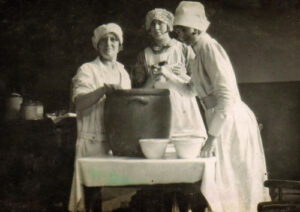
Back in the 1950s, shops rarely displayed Christmas goods before December; unlike today, when you can buy everything you need for the festivities the day following August Bank Holiday Monday. But for me, the first sign that Christmas was on the horizon was arriving home from school to find that Mum had brought down the huge china bowl from the washstand in her bedroom. It would be sitting on the dining room table, surrounded by the makings for Christmas puddings.
She made at least four, two for us and one each for my grandparents who lived next door to each other, just across the street from us.
Assembling the ingredients today would be a fairly straightforward, if lengthy, process with a trip to the supermarket to lift each item from a shelf and place it in a trolley to be paid for at the checkout; the dried fruit already cleaned, suet in a packet already shredded -even carrots can be bought freshly grated. It wasn’t quite so simple for Mum. She’d walk a fair distance to the Co-op with my small sisters in the big coach built pram to buy flour, eggs, dark brown sugar, treacle, currants, sultanas, raisins, mixed spice and nutmeg. The little ones would sit quiet as lambs, mesmerised by the metal cups filled with coins which passed overhead on wires to the cashiers in their glass boxes. On the way home, she’d stop off at Stephens the butcher for a large lump of suet. The carrots, oranges and lemons would be bought at our front door from Tom Kneller the greengrocer, who plied his fruit and veg from the back of his horse drawn cart. Finally, Dad would bring home some
bottles of Mackeson stout from one of the three local pubs which our small street boasted in the days before television became the main entertainment.
That was the easy part. All the dried fruit had to have the pips and stones painstakingly removed before being washed then tossed in flour to dry. Can you imagine performing this fiddly task?
It must have taken hours but Mum never once asked us children to help, it was all mysteriously taken care of while we were at school or out playing. The carrots had to be peeled and grated. The nutmeg, an orange and a lemon, and the solid, greasy lump of suet had to be finely grated too – all by hand using a simple flat metal grater. Mum had been a kitchen maid in the Eye and Ear Hospital in Old Portsmouth, helping prepare the puddings for all the patients and staff, so I daresay, making a few for the family was a piece of cake – or pudding. The dry ingredients were well-stirred then the eggs and stout added to moisten them. They would be blended thoroughly and the aroma coming from the great bowl would be deliciously sweet and spicy. It was then left to marinate for a few hours.
Christmas puddings are an English tradition which began in mediaeval times. The Roman Catholic Church decreed that puddings should be made with 13 ingredients to represent Jesus and the 12 disciples, and be stirred from east to west by every member of the family to honour the Three Wise Men who travelled in that direction to see the Baby Jesus. We’re not Catholics and knew nothing of the origin of this annual ritual but Mum’s pudding did have around 13 ingredients in it and the whole family had a stir – and made a wish. Even my grandparents came across the street in the evening to join in this almost-forgotten tradition, and enjoy a glass or two of stout and maybe a drop of brandy. We also followed the more pagan one of silver threepenny bits being stirred into the mixture and believed that, whoever found a coin in their pudding on Christmas day, would have their wish come true.
Following the stirring and wishing ceremony, the mixture would be ladled into greased basins, covered in greaseproof paper and a clean white cloth tied over the top with string. These were placed in the boiling water-filled copper (where the vests and pants were boiled on Monday washday) and left to quietly simmer all night. The whole house smelt of Christmas pudding – we children couldn’t wait for the big day to come. Nowadays the choice of puddings in the shops is endless: orange, pecan nut, cherries, marmalade, cider, sherry, rum and even chocolate are some of the dominant flavours. One comes with a whole candied orange in the centre. But not one of them – not even Harrods Super Luxury Christmas Pudding – can come close to our dear old mum’s.
Pam Nockemann, Fareham, Hampshire








